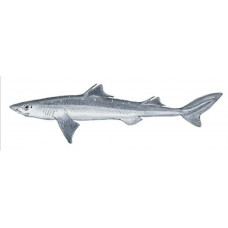Latin name
Squalus acanthias
Other names
Dogfish, dog shark, grayfish, Pacific grayfish, Pacific dogfish, spinarola, California dogfish, blue dog, common spiny fish, spiny dogfish, picked fish, spiky dog, spotted spiny, spurdog, white-spotted dogfish, Victorian spotted dogfish; French: aiguillat; Italian: spinarolo; Japanese: aburatsunozame; Portuguese: galhudo; Russian: katran; Spanish: galludo.
Identification
The body is elongated and slender. Head is pointed. Coloration from above from slate-gray to brownish, sometimes with white spots. The coloration from below is white. There are spines at the beginning of both dorsal fins, they are weakly venomous and serve as a defense.
Distribution
They are found in temperate and subtropical waters. In the western Atlantic, they inhabit from Greenland to Argentina. In the eastern part of the Pacific Ocean - from the Bering Sea to Chile.
Habitat
Sea-bottom species. Usually kept in flocks, sometimes very dense at depths of 10 to 200 m, as an exception - 950 m, at temperatures of 6-14 °C. Individual specimens are not uncommon. It migrates to the middle and surface layers of water. This species is common in coastal waters along some coasts and may occur in enclosed bays and estuaries. It typically lives in deep water and prefers the bottom. In temperate waters, they may enter coastal waters in spring and fall, and head for more northerly areas in summer. In winter, they live mostly in deeper waters along the edge of the continental shelf.
Size
Usually reach a length of 2 to 3 feet. The maximum size is about 63 inches and 20 pounds. In California waters, a large female reaches a length of about 4 feet and weighs 15 pounds. In the Northwest Atlantic, the maximum age of males and females is 35 and 40 years.
Life history and Behavior
Fish are grouped by size, and large sexually mature specimens are grouped by sex. Females are larger than males and produce 3 to 14 young. This species incubates live young, and the gestation period is 18 to 22 months. They live long and do not migrate. Commercial fishing has reduced the population of this slow-growing and unproductive species.
Food and feeding habits
They are voracious and eat almost all small fish, including herring, sardines, anchovies, and smelt. They eat small pinnipeds and crabs. There were cases when they attacked flocks of herring and mackerel, as well as clusters of haddock, cod, sand lance and other species. More active at night. Feeding intensity is somewhat reduced during the feeding period.
Reproduction
A viviparous fish, mating usually occurs in winter and early spring. Embryonic development lasts about two years. Hatching occurs mostly in the spring, but sometimes extends through the summer.
| Classification | |
| Phylum | Chordata |
| Class | Chondrichthyes |
| Squad | Squalidae |
| Family | Squaliformes |
| Genus | Selachimorpha |
| Species | S.acanthias |
| Features | |
| Conservation status | Vulnerable |
| Habitat | Pelagic |
| Life span, years | 75 |
| Maximum body weight, kg | 9.8 |
| Maximum length, cm | 160 |
| Sailing speed, m/s | 25 |
| Threat to people | Edible |
| Way of eating | predator |
Dogfish, Spiny
Tags: dogfish spiny





